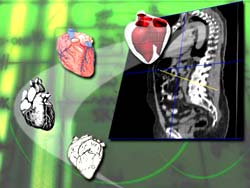Project Summary Page 2 Page1
 As the visual simulator will interactively illustrate the consequences of ballistic wounds to the thorax, the Properties-level model will constitute a simple, integrated heart model that will contain multiple levels of detail, but will fundamentally be responsible for ballistic wound reactivity. The wounding simulation will include mechanical, hemodynamic, and electrophysiological responses. The corresponding data structure will incorporate the possibility of systematic changes in properties and also in geometry, distributed over the four-dimensional simulated heart.
As the visual simulator will interactively illustrate the consequences of ballistic wounds to the thorax, the Properties-level model will constitute a simple, integrated heart model that will contain multiple levels of detail, but will fundamentally be responsible for ballistic wound reactivity. The wounding simulation will include mechanical, hemodynamic, and electrophysiological responses. The corresponding data structure will incorporate the possibility of systematic changes in properties and also in geometry, distributed over the four-dimensional simulated heart.
Detailed pre-existing CT scan data and pre-existing high resolution sonogram data of the thorax will be stored on personal information carriers (or electronic dog tags). This information will be used to align the ballistic trajectory and wounding with post-trauma CT scan and sonogram data after the wounding mapped against the virtual soldier. These tools will provide a demonstration in silico an ability to use the data from the virtual simulated torso to predict outcomes for specific soldiers.
The pre-existing Personnel Information Carrier (PIC), stored on a digital dogtag holomer (Sundial, Inc.; Arlington, VA) data will have been segmented in advance, by optimal mapping of the Foundational Model incorporating variability. Parameters of this segmentation will be stored separately on the PIC for very fast application at the alignment phase of this simulation. This includes indications of both hard-tissue trajectory (e.g. entry and exit sites vis-a-vis the rib cage) and soft-tissue damage (to heart and to lungs).
The culmination of the project is a demonstration of the feasibility and validity of the virtual soldier. The demonstration will provide an opportunity to integrate the individual projects and tools into a unified program. This will ensure a consensus among operating standards and methodologies. A successful demonstration will show that the structural abnormalities of the virtual heart predict the abnormalities of the actual heart after trauma. Furthermore, the physiologic response of the event on the virtual cardiovascular system will predict the real-time recording of the actual event. This is an important validation of the feasibility of the virtual soldier.
At the core of this demonstration will be a powerful inference engine for continually reassessing the unfolding understanding of the damaged heart by predictor-corrector statistics (the familiar Kalman Filter design). From instrumentation of the performance of the injured heart, it will be possible to re-estimate the initial estimates of the extent of the organ-tissue damage (e.g., the net area of functioning myocardium remaining); and from the re-estimated geometry, together with imagery acquired however imprecisely over the course of "treatment" (first from ultrasound and later form CT scans), it will be possible to re-assess the nature of disordered cardiac function that resulted from the injury, so as to simulate the steadily more and more intelligent interventions that would follow from such improved information. In a word, the prior model of "the" wounded heart will be initially tuned to parameters visible from the admission rescan and subsequently further retuned in light of actual cardiac performance. To this end, the database of wound information will include actual experience with porcine models, even though the database of organ-tissue properties will be based mainly on human material.
